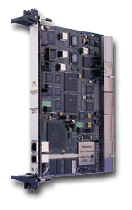
CPC396 Dual T3/H.110 TDM Circuit Switch

The desire for density and high performance in Next-Generation telecom and IP telephony systems continues to grow at a rapid pace. The CPC396 Dual T3/H.110 TDM Circuit Switch, part of Performance Technologiesˇ¦ IPnexus™ product family, meets these needs by providing telecom equipment manufacturers and integrators with full switching of two DS-3 communications interfaces (1344 DS-0s) on one single or two independent H.110 buses.
The CPC396 has been specifically designed to be the ideal adapter for IP telephony applications requiring the manipulation of large numbers of voice and data circuits from the telco network to the H.110 bus. The CPC396 helps designers of carrier-grade VoIP, VoATM, VoDSL media gateways, wireless infrastructure equipment, and other voice/data devices get to market quicker and more profitably.
The PICMG 2.16 compliant CPC396 is an adaptable platform designed with an onboard MPC8260 PowerQUICII RISC communications processor. Combined with an embedded Linux operating system and dual onboard Ethernet, the CPC396 operates as a fully programmable communications subsystem capable of intra-chassis communication using the PCI bus, or Ethernet.
| Carrier-Grade Dual DS-3 Communications Interface for 6U CompactPCI Systems | Ideal for high density voice and data applications for IP telephony systems |
| Motorola MPC8260 PowerQUICC®II Processor | Integrated communications functionality managed by an MPC603e PowerPC core |
| PICMG 2.16 Compliant | Capable of operating in conventional CompactPCI chassis or packet switched backplane configurations |
| Dual 10/100 Ethernet | Provides redundant IP connectivity for high reliability carrier-grade solutions |
| Dual H.110 Buses | Up to 1344 time slots can be switched between one or both T3s, and one single or two independent H.110 buses |
| NexusWare Development Environment | Embedded Linux OS manages all onboard functions and offers an open API for development |
| 64MB Dedicated Processor DRAM Memory | Handles extensive onboard traffic and protocol requirements |
| Hot Swappable | Complies with the latest PICMG Specification |
| Rear Panel I/O with Passive Transition Module | Passive transition module facilitates hot swap and eliminates failure points |
The architecture of the CPC396 capitalizes on the Motorola MPC8260 PowerQUICCII Processor. The advanced feature set of the MPC8260 allows for superior handling of two fully channelized T3 spans (1344 DS-0s) as an entire stand-alone subsystem.
In addition, the CPC396 offers two fully-channelized T1/E1/J1 ports. These ports can be used for various applications such as signaling or system management over a WAN connection.
The CPC396 supports complete DS-0 to DS-3 multiplexing. It can switch 1344 DS-0 channels (2688 time slots) to a single H.110 bus (J4) or it can be used to switch the 672 time slots of each T3 link to a dedicated H.110 channel. Supporting the ECTF H.110 specification, each T3 span can link to either the standard J4 or proprietary J3 connector.
The CPC396 complies fully to the latest PICMG 2.1 Hot Swap specification, enabling trouble-free hot insertion and extraction of modules, a critical requirement in building a carrier-grade system.
Other features of the CPC396 include 64MB of DRAM allowing the CPC396 to execute protocols and manage extreme DS-0 density directly onboard. It also provides a monitor port and console port for upgrades and management.
Running the Linux-based NexusWare development environment, the CPC396 is a complete, stand-alone TDM switch that may be managed via the cPCI bus, console port or redundant out-of-band Ethernet ports via SNMP or TCP/IP based API.
It includes client and server support for TFTP system upgrades, BootP and DHCP, as well as local (CPCI bus) and remote APIs for Solaris, Linux, and WindowsNT.
| Interface | 2 T3 Ports with 2432 time slots switchable between local and 2 ECTF
H.110 buses 2 DS-3 (1344 time slots) switchable to/from one H.110 bus 56 T1 Framing Channels (28 per T3) 2 10/100 Ethernet ports |
| Processor | Motorola MPC8260 PowerQUICC®II (MPC603e core) 64 bit data and 32 bit address bus |
| Memory | 64MB Dedicated DRAM 16MB Flash PROM |
| Compliance | CPCI Revision 2.1, including all PCI required configuration registers
and protocols. PICMG 2.0 R 3.0, 5 CT bus, ECTF H.110, PICMG 2.1 Hot Swap PICMG 2.16 CompactPCI Packet Switched Backplane |
| Physical Interface | CPCI 32/64 bit/33MHz Interface H.110 Rear Panel Pinout via J3 and J4 Connectors Dual Ethernet 10/100TX Dual Serial Management Controllers Console Serial Port (RJ-11) Front Panel LEDs for Link Activity, System Status and Fault Indication Rear Panel I/O for two T1 Monitor Ports |
| PSTN Interfaces | Dual T3 LIUs and framers with support for M13 and C-bit parity Framing
Formats B3ZS/HDB3 Encoding and T3 Alarm Indication Signal (AIS) with Remote Alarm Indication (RAI) |
| Framing Protocols | AMI/B8ZS, D-4, ESF, DS-1, PRI, Direct DS-3 to DS-0 Conversion |
| Embedded Linux OS | T1/T3 Framer Management Dual H.110 CT Bus Switching Driver Flash File System Dual Console Line Interfaces In-system Firmware Upgrade Capability BootP Client/Server DHCP Client/Server TFTP Client/Server |
| Management | SNMPv1 with support for MIB II (RFC1213) DS-1 MIB (RFC2495) DS-3 MIB (RFC2496) PTI Enterprise MIB for extended monitoring configuration and H.110 circuit setup Local cPCI based API Remote TCP/IP based API with support for Windows NT, Solaris and Linux |
| Agency Certifications | FCC Class A, UL 1950, CE (pending) NEBS Level 3 friendly |
| MTBF | > 200,000 power-on hours (POH) |
| Power | 12.94 watts maximum (4.0 A @ +3.3 V) |
| Dimenstions | 6U Eurocard form factor |
| Temperature | Operating: 0˘X to 50˘X C (32˘X to 122˘X F) Non-operating: ˇV20˘X to 80˘X C (ˇV4˘X to 176˘X F) |